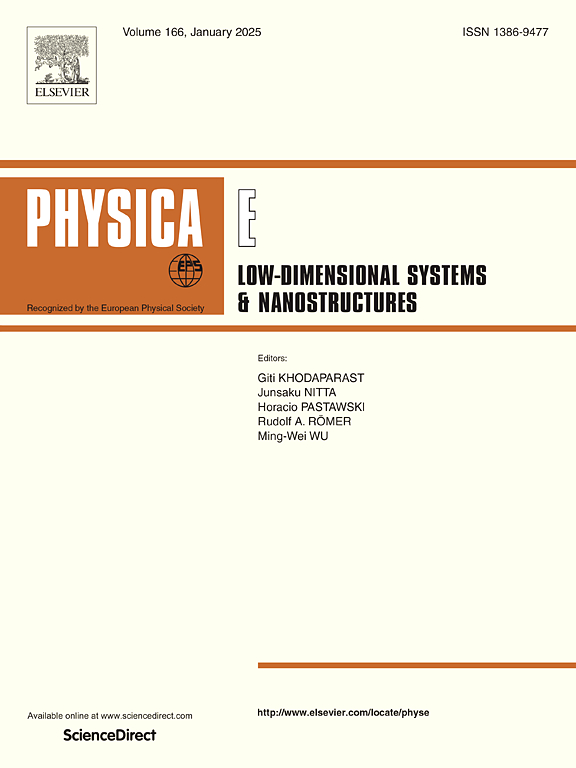A tunable terahertz metamaterial perfect absorber based on graphene for cancer cell detection
IF 2.9
3区 物理与天体物理
Q3 NANOSCIENCE & NANOTECHNOLOGY
Physica E-low-dimensional Systems & Nanostructures
Pub Date : 2025-07-07
DOI:10.1016/j.physe.2025.116323
引用次数: 0
Abstract
This paper presents the design of a terahertz metamaterial absorber. This design incorporates a three-layer structure: the bottom layer (metal), the middle layer (medium material), and the top layer (patterned graphene), including graphene square frame and a double Z-shaped structure. The simplicity of this design streamlines the manufacturing process. Simulations were conducted using CST Microwave Studio. The results show that the absorber exhibits two absorption peaks with absorptivity of 90.86% and 100% at 3.85 THz and 5.04 THz, respectively. It is found that applying an external bias voltage can modulate the electrical conductivity of graphene, enabling dynamic regulation of the absorptivity and resonant frequency without altering the structural parameters. Additionally, the absorber’s structure is rotationally symmetric, making it polarization-insensitive. And the maximum incident angle for maintaining spectral stability can reach up to 80°. The very important feature of the proposed absorber is its high sensitivity of 1.64 THz/RIU, making it well-suited for practical applications in refractive index sensing. Meanwhile, the simulation for the detection of MCF-7 cancer cells was conducted. And the sensitivity of it is 1.714 THz/RIU. This level of sensitivity ensures effective detection of the target analytes.
一种基于石墨烯的可调谐太赫兹超材料完美吸收剂,用于癌细胞检测
本文介绍了一种太赫兹超材料吸收器的设计。本设计采用三层结构:底层(金属),中间层(介质材料),顶层(图案化石墨烯),包括石墨烯方形框架和双z形结构。这种设计的简单性简化了制造过程。利用CST微波工作室进行了模拟。结果表明:该吸收剂在3.85 THz和5.04 THz处呈现出90.86%和100%的吸收峰;研究发现,施加外部偏置电压可以调节石墨烯的导电性,从而在不改变结构参数的情况下动态调节吸光率和谐振频率。此外,吸收器的结构是旋转对称的,使其对极化不敏感。保持光谱稳定性的最大入射角可达80°。该吸收器的一个重要特点是它的高灵敏度为1.64太赫兹/RIU,使其非常适合于折射率传感的实际应用。同时,对MCF-7癌细胞的检测进行了模拟。灵敏度为1.714 THz/RIU。这种灵敏度水平确保了目标分析物的有效检测。
本文章由计算机程序翻译,如有差异,请以英文原文为准。
求助全文
约1分钟内获得全文
求助全文
来源期刊
CiteScore
7.30
自引率
6.10%
发文量
356
审稿时长
65 days
期刊介绍:
Physica E: Low-dimensional systems and nanostructures contains papers and invited review articles on the fundamental and applied aspects of physics in low-dimensional electron systems, in semiconductor heterostructures, oxide interfaces, quantum wells and superlattices, quantum wires and dots, novel quantum states of matter such as topological insulators, and Weyl semimetals.
Both theoretical and experimental contributions are invited. Topics suitable for publication in this journal include spin related phenomena, optical and transport properties, many-body effects, integer and fractional quantum Hall effects, quantum spin Hall effect, single electron effects and devices, Majorana fermions, and other novel phenomena.
Keywords:
• topological insulators/superconductors, majorana fermions, Wyel semimetals;
• quantum and neuromorphic computing/quantum information physics and devices based on low dimensional systems;
• layered superconductivity, low dimensional systems with superconducting proximity effect;
• 2D materials such as transition metal dichalcogenides;
• oxide heterostructures including ZnO, SrTiO3 etc;
• carbon nanostructures (graphene, carbon nanotubes, diamond NV center, etc.)
• quantum wells and superlattices;
• quantum Hall effect, quantum spin Hall effect, quantum anomalous Hall effect;
• optical- and phonons-related phenomena;
• magnetic-semiconductor structures;
• charge/spin-, magnon-, skyrmion-, Cooper pair- and majorana fermion- transport and tunneling;
• ultra-fast nonlinear optical phenomena;
• novel devices and applications (such as high performance sensor, solar cell, etc);
• novel growth and fabrication techniques for nanostructures

 求助内容:
求助内容: 应助结果提醒方式:
应助结果提醒方式:


